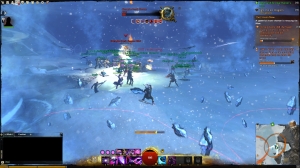Dynamic quest content in 2013: GW2, FFXIV, and WoW
Late last year I wrote a bit about my hopes for dynamic quest content in MMOs. Dynamic quest content was a promise to break away from a fixed linear content model where players are pushed along one or — if you were lucky — a few fixed questing tracks in a game. Once those were complete, players mostly had to wait until new content was released or perform some repetitive tasks, usually in the form of daily quests. This is killer for games whose entire existence is based on a persistent world. Several games have incorporated dynamic content into their play models, so I thought it was worth taking a look back at my experiences with how they implemented this potentially ground-breaking technology.
Guild Wars 2
 Guild Wars 2 was the first game to try and incorporate dynamic content. Early on, running around in new zones was exciting. Sure, every now and again you’d run into the same events, but overall it felt like every time you entered a zone, you’d end up having a slightly different gaming experience. That was a huge plus, and I think it ultimately gave the game some good legs for both myself and my wife. The problem was that even though the event chains were extensive, they weren’t random. In fact, they were scripted along relatively narrow paths. And true to form, players found a way to optimize the patterns. I don’t think either of us is entirely sure when the change happened, but over time as players started figuring out patterns in zones and ArenaNet started adding more rewards for dynamic events, doing those events just stopped being fun. The champion farm was born. Masses of players would run in circles around zones knocking off supposedly challenging mobs like they were nothing to get some great rewards. And they can get nasty about it if anyone messes up the cycle. This was particularly bad in low level zones where new players can be exposed to that as some of their first gaming experiences. All the complexity of the dynamic events boiled down into a circuit course with a mob of players that trivialized the encounters.
Guild Wars 2 was the first game to try and incorporate dynamic content. Early on, running around in new zones was exciting. Sure, every now and again you’d run into the same events, but overall it felt like every time you entered a zone, you’d end up having a slightly different gaming experience. That was a huge plus, and I think it ultimately gave the game some good legs for both myself and my wife. The problem was that even though the event chains were extensive, they weren’t random. In fact, they were scripted along relatively narrow paths. And true to form, players found a way to optimize the patterns. I don’t think either of us is entirely sure when the change happened, but over time as players started figuring out patterns in zones and ArenaNet started adding more rewards for dynamic events, doing those events just stopped being fun. The champion farm was born. Masses of players would run in circles around zones knocking off supposedly challenging mobs like they were nothing to get some great rewards. And they can get nasty about it if anyone messes up the cycle. This was particularly bad in low level zones where new players can be exposed to that as some of their first gaming experiences. All the complexity of the dynamic events boiled down into a circuit course with a mob of players that trivialized the encounters.
Final Fantasy XIV: A Realm Reborn
The amazing thing is that even if the model the Guild Wars 2 implemented wasn’t perfect, it’s started to permeate into other MMO contenders. Since I had given Final Fantasy XIV a try when it was first released, I decided to take advantage of my free month. I’d not really followed the games refurbishment, but I was particularly surprised to find out about the FATE system. One of friends told me about the FFXIV’s dynamic quests before I jumped in: “You have your story quests as well that are specific to you and your personal progression through the game, you have class quests for all the different classes, you have FATEs which are basically like guild wars style events, in fact almost EXACTLY the same events in some cases.”
I’m not going to be quite so favorable as to say FFXIVs FATEs were on par with Guild War 2’s dynamic quests, but they definitely had a lot of similarities. Indicators on the mini-map alerted players in the region to crises that demand that players flock from all around. They can last for for up to 15 minutes and have even less impact on the game world. But they did make running around at least slightly more variable. Unlike GW2 dynamic events, however, players are incentivized to participate in FATES thanks to their experience rewards. There were only enough story quests to level your main class so FATE circuits became one of the primary mechanisms for players to level up alternate classes. This was annoying because as with GW2, the events seemed to not scale terribly well past a certain threshold of players. Ultimately, I didn’t play the game for more than a month or so. I can’t say that the FATEs were the single reason, but they definitely didn’t help.
World of Warcraft: Mists of Pandaria
Which brings me to my most current gaming experience with dynamic events: World of Warcraft’s Timeless Isle. I’d stopped played World of Warcraft about a year ago, but the recent announcement for many changes to game in the next expansion at Blizzcon prompted a lot of my old friends to return to the game. We’re going to see if Blizzard’s new “it’s more fun to play with friends” approach to design was as genuine as it seemed listening to them talk about it. To my surprise, I found out that they’d been slowly adopting dynamic event content into their game as well. Thunder Isle in patch 5.3 had a few small dynamic events and the Timeless Isle in patch 5.4 did away completely with scripted daily quests in favor of small little events on the Timeless Isle.
 When I first got to the Timeless Isle, I couldn’t help but notice was a few players seemingly running in a circuit. It didn’t take long to figure out that there are a relatively fixed number of possible events and most people just run around looking for them. As with FFXIV and GW2, Blizzard opted to place some small call-outs on the map to alert players to events and rare bosses spawning on the island. Players also tend to call out when then events are up, resulting in mobs of players converging on whatever events happen to be active, just like the champion farms of Guild Wars 2. Overall, there’s a decent range of larger events and smaller events on the island, but the number is so small that it becomes fairly repetitive quickly. Blizzard’s announced there will be more content like this in Warlords of Draenor, so it’ll be interesting to see what they’ve learned and if they can expand on what seems like an growing experiment for the developers.
When I first got to the Timeless Isle, I couldn’t help but notice was a few players seemingly running in a circuit. It didn’t take long to figure out that there are a relatively fixed number of possible events and most people just run around looking for them. As with FFXIV and GW2, Blizzard opted to place some small call-outs on the map to alert players to events and rare bosses spawning on the island. Players also tend to call out when then events are up, resulting in mobs of players converging on whatever events happen to be active, just like the champion farms of Guild Wars 2. Overall, there’s a decent range of larger events and smaller events on the island, but the number is so small that it becomes fairly repetitive quickly. Blizzard’s announced there will be more content like this in Warlords of Draenor, so it’ll be interesting to see what they’ve learned and if they can expand on what seems like an growing experiment for the developers.
Observations
Based on the three games, I’ve come up with a few general observations about what I’d like to see in the next generation of dynamic quest content.
- Most dynamic quests feel “right” for about 2-10 people, beyond that even if monsters scale in health based on the number of players the social dynamic seems to crumble. Announcing the quests to crowded zones tends to draw too many people; it may be worth having several pools of events that can happen in a given zone based on how many people are around (e.g. if a zone is crowded, mostly large scale events designed to accommodate that many occur).
- Cause and effect is still too predictable, and thus exploitable, by the general player base. Most zones seem to have too few events that get cycled through. Logging in results in less of a question of “what will I experience today?” than “when will I experience these events?” It’d be nice if the pool of possible events was large enough and variable enough that you might only see a given event once a week or so.
- Dynamic content can tend to feel disconnected due to the events being somewhat isolated. Responding to individual crisis after individual crisis can feel a bit futile. WoW and Guild Wars have implemented zone wide rewards for participating in certain events in a zone, but these still fall a bit short of a compelling reason why a character is running around after a point. It’d be nice if maybe the game could string a few events together to create individual meta-objectives for players.
- Dynamic content still mostly only impacts the game world locally. In the best implementations, infrastructure and player services can be disrupted, but it’s almost always completely temporary and usually only a minor nuisance. In the worst, the events do absolutely nothing to affect the game. Ideally, it’d be better if a dynamic event affected a wider area. For example, a conflict a few zones over could noticeably affect prices or availability of goods to incentivize players to spread out and also give the world a larger sense of connectivity.
The introduction of dynamic quest content has definitely left a mark on the MMO genre and is becoming a fixture with new, redone, and old games. I’ve not been shy about how excited I am that these games are moving beyond linear content; but I’m also coming to realize that sometimes theory can only take you far. I don’t know yet what the future of dynamic content is going to be in MMOs, but it almost certainly is not yet mature. My hope is that someone can find a way to keep it fresh enough that we can avoid the compulsion to run around in circles waiting for random stimuli. I’d rather wander and be pleasantly surprised, than feel like I’m piling in for the morning commute.


I know that EVE is an entirely different beast of an MMO altogether, but I feel like it deserves a mention given that it, too, implemented dynamic content with the Incursion system in the like-named expansion (almost two years before the release of Guild Wars 2).
While Incursions have a pretty negligible negative effect on players in High Security space, they can be a real pain in the ass for the dedicated players running in losec and nullsec, with penalties to incomes as well as player damage output in the affected systems. Rewards are good, but like everything else that’s profitable in EVE, the risk (and investment required) is commensurate with the reward. Incursions are further complicated by the ever-present threat of PVP.
I would also say that the system is not perfect, but it’s helped to add another direction that players can travel in what is already an extremely open-ended game.
In fact that may actually be the question we should be asking — can you successfully graft a piece of open-ended gameplay onto a system which is otherwise closed but set in an open-world? After all, games like WoW and Guild Wars and Final Fantasy are essentially not open-ended in their core gameplay. They have a large but finite number of crafted experiences that you can either choose to take part in or not take part in.
For a game like EVE, which is naturally more open-ended in its gameplay due to the inclusion of genuine human interaction as one of its core game concepts, dynamic content like the Incursions seem to be a natural extension of core mechanics.
I’m not sure that it’s as possible to achieve complete synergy with dynamic quest content with a game whose momentum isn’t already carrying it in the direction of open-ended and emergent gameplay, but I sure hope they keep trying. I’d love to be proven wrong there.
That’s a fair point to make, Matt (Hi, btw!). I think you’re absolutely right that part of the problem with dynamic content in a lot of these games is that the open content feels tacked onto the otherwise very directed experience. Guild Wars 2 did better than others at mitigating this because they integrated dynamic events from the start, but as I noted they still far short of feeling like you’re changing the world.
I limited the scope of this article to only those games I’ve been playing, but I’ve always had a lot of respect for EVE as a forerunner in the MMO space. That said, I’d never quite been able to get into it despite my appreciation for its design and construction. For all it’s openness, I think it’s also very easy to lose a sense of purpose – where your actions feel meaningless in the larger scheme until you can get hooked into the human element. That’s not to say the sense of purpose is any more real than that imposed by more structured games, but the illusion does seem to be sticky enough for most players to get over that hump.
There’s a natural push-pull going on in any MMO between openness of world and sense of individual progression. They are persistent worlds that you want players to come back too, but it’s hard to create a context for that continued game-play without constructing it. While EVE’s approach is definitely one way, and the amusement park approach another, I think what intrigues me is the idea of a hybrid approach. Ultimately, I think to get there, these dynamic micro-events need some sort of arbiter to construct and connect them. Guild Wars II has been pushing out monthly patches that bring in some special dynamic events for each patch. While they are a far cry short of a total dynamic experience since the outcome of a particular month doesn’t really impact the next.. imagine if they didn’t have to make those and the game constructed monthly campaigns on it’s own taking the inputs of players from the previous month. And multiple monthly campaigns strung into larger quarterly campaigns. You’d always been striving towards intermediate goals with smaller goals along the way.